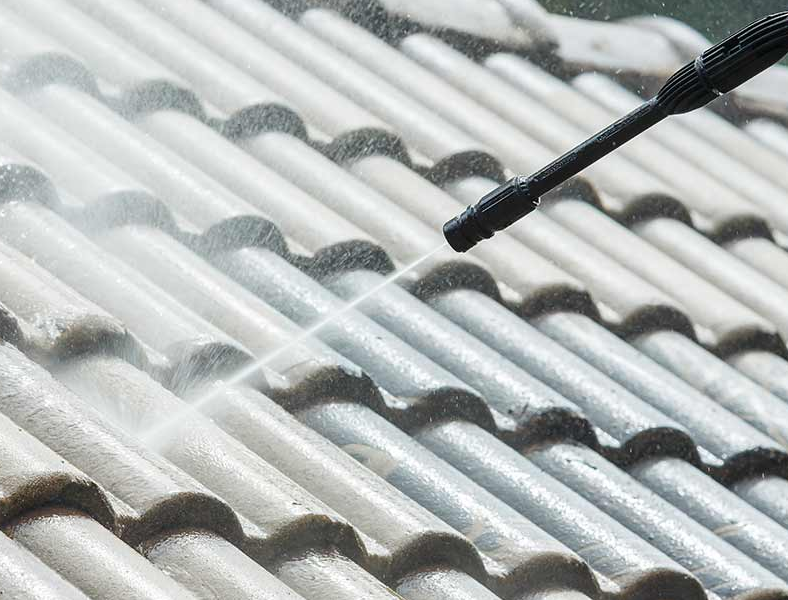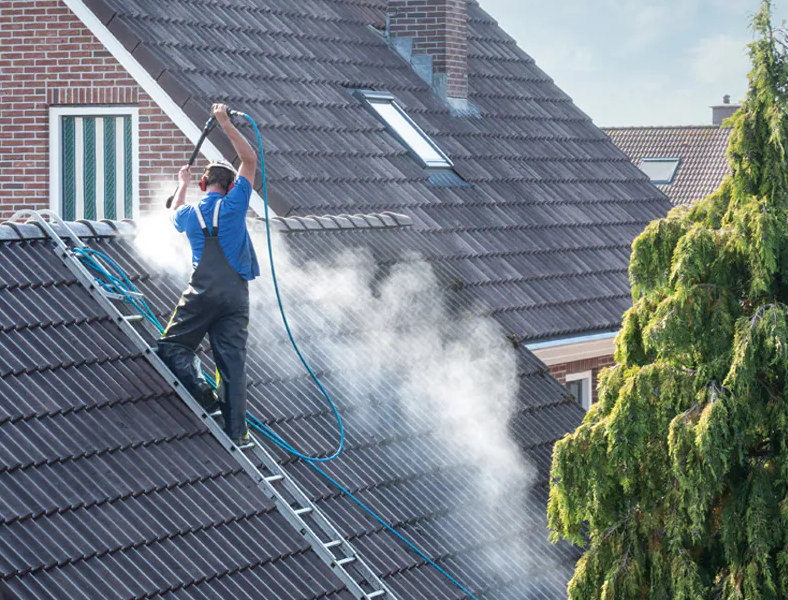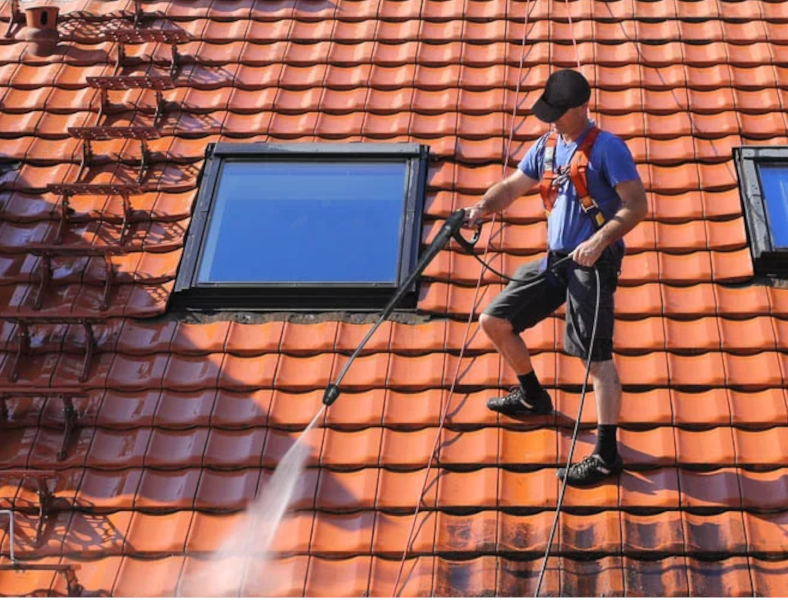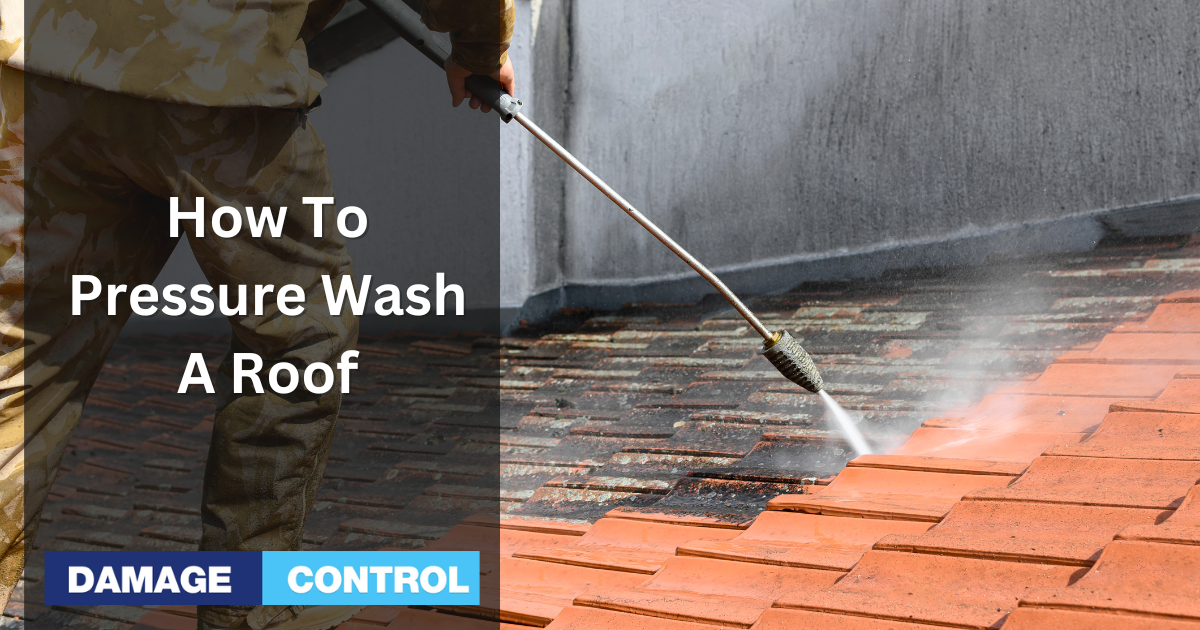We all know that feeling – you take a good look at your home and realize that your roof could use some TLC. Roof cleaning matters more than you might think, and it's not just about aesthetics. A clean roof can prolong its lifespan, prevent damage, and enhance your home's curb appeal. That's where pressure washing comes in!
This powerful cleaning method can work wonders for your roof, removing dirt, grime, and even pesky algae. In this guide, we'll explore the ins and outs of roof pressure washing, so you can enjoy a spotless roof and a home that shines with pride.
Types of Roofs and Pressure Washing Techniques
Asphalt Shingles: Gentle but Effective
Asphalt shingles are common, but they also require a delicate touch when pressure washing. To avoid damaging the shingles, use a low-pressure technique called “soft washing.” This method combines gentle water pressure with specialized cleaning solutions to remove dirt and grime without harming your roof.
Tile Roofs: A Sturdy Clean
Tile roofs are known for their durability, but that doesn't mean they're immune to dirt and algae. Pressure washing is an excellent way to clean tile roofs, but make sure to use moderate pressure and avoid spraying water directly under the tiles. This will prevent any water damage and keep your roof in tip-top shape.
Metal Roofs: Fast and Efficient
Metal roofs are a breeze to clean with pressure washing! Thanks to their smooth surfaces and resistance to water, metal roofs can handle higher water pressure, making the cleaning process fast and efficient. Just remember to keep the pressure washer at a safe distance and use a consistent sweeping motion to prevent damage.
Wood Shakes and Shingles: A Delicate Balance
Wood shakes and shingles require a careful approach when it comes to pressure washing. Too much pressure can cause damage or even strip off the protective coating. Opt for a soft wash method with a suitable cleaning solution to preserve your wood roof's beauty and longevity.
Slate Roofs: Precision Matters
Slate roofs are stunning, but they can also be fragile. When pressure washing a slate roof, use a low-pressure setting and aim the water spray at a downward angle to prevent water from getting underneath the slates. This precision technique will ensure your slate roof stays clean and damage-free.
Note: This should not be a DIY project. Slate is fragile and hard to walk on without breaking slates. You would likely spend more on repairs in the first 20 minutes than you would on calling a professional to clean it. It takes someone with.
The Pressure Washing Process

Step-by-Step Guide: 6 Simple Steps to a Pristine Roof
1. Safety First, Folks!
Before you even touch that pressure washer, ensure you take the proper safety precautions. Wear protective eyewear, gloves, and sturdy footwear with good grip. And don't forget a safety harness if you're climbing up on the roof!
2. Prepping the Work Area
Before getting started, clear the area around your home, remove any loose debris from the roof, and cover delicate plants or fixtures to protect them from the spray.
3. Picking the Right Gear
Selecting the proper pressure washer and accessories is crucial to ensure a successful roof cleaning experience. Here's what you need to know to make the right choice for your roof type:
The Pressure Washer: Adjustability is a Must
When choosing a pressure washer, opt for a model with adjustable settings. This feature allows you to fine-tune the pressure to suit your specific roof material, preventing any potential damage. For instance, asphalt shingles and slate roofs require a lower pressure setting, while metal roofs can handle higher pressure.
Nozzles: Size Matters
Pressure washer nozzles come in various sizes and spray patterns, directly affecting the water stream's pressure and cleaning power. Wider nozzles create a gentler pressure, making them ideal for delicate roof surfaces. On the other hand, narrower nozzles produce a more concentrated and powerful spray suitable for sturdy materials like metal or tile roofs.
Here's a quick guide to help you choose the right nozzle for your roof cleaning project:
- White (40-degree nozzle): Often referred to as the “soft wash” nozzle, this attachment provides the widest spray angle, making it perfect for the gentlest cleaning of asphalt shingles, wood shakes, and other delicate roof materials.
- Green (25-degree nozzle): This nozzle offers a wide spray angle, suitable for gently cleaning a variety of roof surfaces. It's a versatile choice that can be used on materials like asphalt shingles and wood shakes without causing damage.
- Yellow (15-degree nozzle): With a slightly narrower spray pattern, this nozzle is ideal for cleaning tile or concrete roofs, where moderate pressure is needed to remove dirt and grime effectively.
- Red (0-degree nozzle): This high-pressure nozzle creates a concentrated jet of water, suitable for cleaning hard-to-reach spots or stubborn stains. However, be cautious when using this nozzle, as it can cause damage to roof materials if not used correctly.
Slathering on Cleaning Solutions
Apply a cleaning solution designed for your roof material to help loosen dirt and grime. Let it sit for a few minutes (or as directed on the product) to work its magic before starting the pressure washing process.
Mastering Pressure Washing Techniques
Start at the top of your roof and work your way down, using smooth, overlapping strokes. Keep the pressure washer's nozzle at a safe distance from the roof to avoid damage. And always spray at a downward angle to prevent water from getting under the shingles or tiles.
Rinsing and Wrapping Up
After you've finished pressure washing, thoroughly rinse your roof with clean water to remove any leftover cleaning solution. Once everything's clean and dry, inspect your roof for any damage or areas that may need extra attention.
Follow this step-by-step guide to achieve a spotless roof and give your home a much-needed facelift. Just remember to take your time, prioritize safety, and use the right techniques for your roof type.
Pressure Washing Equipment: Your Arsenal for a Spotless Roof
Gas vs. Electric: Pressure Washer Varieties
When it comes to pressure washers, you'll find two main types: gas-powered and electric. Gas pressure washers typically offer more power and are ideal for larger jobs, while electric pressure washers are quieter, more eco-friendly, and perfect for smaller tasks. Consider your roof size, cleaning needs, and personal preferences when choosing between these two options.
Power Meets Precision: Choosing the Perfect PSI
PSI, or pounds per square inch, measures the pressure produced by your washer. Selecting the right PSI level for your roof type is essential to prevent damage. Lower PSI levels (1,000-2,000) are suitable for delicate materials like asphalt shingles and wood shakes, while higher PSI levels (2,500-3,000) work best for sturdier roofs like tiles or metal.
Nozzle Know-How: Mastering Your Attachments
As mentioned earlier, using the appropriate nozzle is crucial for effective and safe roof cleaning. Familiarize yourself with the different nozzle types and their corresponding spray angles to ensure a thorough and damage-free cleaning experience.
Chemical Tanks and Downstream Injectors: Enhancing Your Pressure Washer
When selecting a pressure washer, look for a model with a built-in chemical tank and a downstream injector. These features allow you to mix cleaning solutions directly into the water stream, ensuring an efficient and effective cleaning process. With the right pressure washer, you can easily apply your chosen cleaning solution to tackle even the most stubborn grime and stains.
Extending Your Reach: Wands and Gutter Cleaners
Long wands and gutter cleaner attachments can make accessing hard-to-reach areas on your roof easier. These extensions allow you to clean from a safer distance, reducing the risk of falls or damage to your roof. Look for telescoping wands and specialized gutter cleaner attachments to add to your pressure washing toolkit.
Picking the Best Cleaning Solutions: Your Secret Weapon
Pairing your pressure washer with the right cleaning solution can make all the difference in the outcome of your roof cleaning project. Choose a cleaner specifically designed for your roof material, and follow the product instructions for optimal results. Remember, using a suitable cleaning solution enhances the cleaning process and helps protect your roof from potential damage.
DIY vs. Hiring a Pro: Making the Right Choice for Your Roof

The DIY Pressure Washing Debate: Is It Worth It?
Pressure washing your roof can be a rewarding DIY project, but it's not for everyone. It requires time, skill, and the right equipment to do the job effectively and safely. If you're a hands-on homeowner with experience using a pressure washer, you might be up for the challenge. Just make sure you're familiar with your roof type, follow safety guidelines, and use the appropriate techniques to avoid damage.
When to Call in the Experts: Knowing Your Limits
Sometimes, it's best to leave roof cleaning to the pros. If you're inexperienced with pressure washing, dealing with a particularly dirty or delicate roof, or simply don't have the time or resources to tackle the task yourself, hiring a professional is a wise choice. They'll have the expertise, tools, and experience to get your roof looking its best, while you can relax and enjoy the results.
Tips for Picking a Top-Notch Pressure Washing Company: Finding Your Perfect Match
When it comes to hiring a pressure washing company, do your research to find the best fit for your needs. Here are a few tips to help you choose a top-notch provider:
- Read Reviews: Look for online reviews to get a sense of the company's reputation and customer satisfaction. Pay attention to details like timeliness, professionalism, and quality of work.
- Verify Insurance and Licensing: Ensure the company has the proper insurance coverage and licenses to operate in your area. This protects you in case of accidents or damage during the cleaning process.
- Request References: Ask the company for references from previous clients, and don't hesitate to follow up with them to get firsthand feedback on their experience.
- Get Multiple Quotes: Compare quotes from several companies to find the best value. Remember, the cheapest option isn't always the best, so weigh the cost against quality and reputation.
- Ask About Techniques and Equipment: Inquire about the company's pressure washing process, equipment, and cleaning solutions. Ensure they use methods appropriate for your roof type to avoid potential damage.
With these tips in mind, you'll be well-equipped to make an informed decision about whether to tackle roof pressure washing as a DIY project or enlist the help of a professional. Whatever you choose, your roof will thank you for the TLC!
Keeping Your Roof in Tip-Top Shape After Pressure Washing: Maintenance Matters
Regular Roof Check-ups: Stay Vigilant, Friends
Routine inspections are key to maintaining a clean and healthy roof. Make it a habit to check your roof at least twice a year, or after significant weather events. By staying on top of potential issues, you can address them early and prevent costly repairs down the road.
Battling Algae, Moss, and Lichen Growth: Wage War on Unwanted Invaders
Keep an eye out for algae, moss, and lichen growth on your roof, as they can cause damage over time. If you spot any signs of these pesky organisms, use a gentle cleaning solution or call in a professional to remove them before they become a bigger problem.
Cleaning Gutters and Downspouts Like a Pro: A Crucial Component
Your gutters and downspouts play a crucial role in maintaining a clean roof. Ensure they're free of debris, such as leaves and twigs, to prevent water buildup and potential damage. Regularly clean and inspect your gutters to keep water flowing smoothly and protect your roof from unwanted moisture.
Handling Damaged or Missing Shingles: Act Fast, Save Money
If you notice any damaged or missing shingles during your roof check-ups, address the issue promptly. Damaged shingles can lead to water leaks and further damage if left unattended. Replace or repair damaged shingles to keep your roof in optimal condition and extend its lifespan.
By following these maintenance tips, you can keep your roof looking great and functioning at its best after a thorough pressure washing. Remember, a well-maintained roof is essential for protecting your home and enhancing its curb appeal, so give it the care it deserves!
Safety Tips for Roof Pressure Washing: Play It Safe, Friends
Suiting Up with Personal Protective Equipment: Dress to Protect
Wearing the right personal protective equipment (PPE) when pressure washing your roof is essential. This includes safety goggles, gloves, non-slip shoes, and even ear protection if your pressure washer is particularly loud. During cleaning, PPE will help keep you safe from flying debris, chemicals, and other potential hazards.
Ladder Safety 101: Climb with Confidence
Using a ladder to access your roof? Take ladder safety seriously. Ensure your ladder is on stable, level ground and extends at least 3 feet above the roof's edge for secure footing. Always maintain three points of contact (two hands and one foot, or two feet and one hand) when climbing, and never stand on the top rungs.
Avoiding Electrical Hazards: Steer Clear of Shocking Situations
Pressure washers and electricity don't mix. Before you start cleaning, check for overhead power lines and ensure they're at a safe distance from your work area. Be mindful of electrical outlets and exterior lights, too. Keep cords, plugs, and pressure washer components dry to reduce the risk of electrical hazards.
Protecting Your Landscaping: Save Your Plants from Pressure Washing Peril
Pressure washing your roof can send water, cleaning solutions, and debris flying onto your landscaping. To protect your plants and lawn, cover them with tarps or plastic sheeting before you start cleaning. Also, be mindful of where you're directing the water spray to minimize the impact on your greenery.
By following these safety tips, you can pressure wash your roof effectively and safely, keeping both you and your property out of harm's way. Safety should always be a top priority when tackling any home improvement project!
Common Mistakes to Steer Clear of for a Successful Roof Pressure Washing

Overdoing the Pressure: Less is More
One of the most common mistakes in roof pressure washing is using too much pressure. Excessive pressure can damage your roof, dislodge shingles, and cause water infiltration. Always start with the lowest pressure setting and gradually increase if necessary. Remember, a gentle touch is often all you need to achieve a clean roof without risking damage.
Skimping on Cleaning Solution: The Power of Proper Cleaning Agents
Using an appropriate cleaning solution is crucial for effective roof cleaning. Don't skimp on the cleaning solution or rely solely on water pressure alone. The right cleaning agents can help break down dirt, algae, and grime, making your pressure-washing efforts more successful. Follow the manufacturer's instructions for proper dilution and applying cleaning solutions.
Overlooking Safety Measures: Protect Yourself and Your Property
Safety should never be overlooked when pressure washing your roof. Skipping safety measures like using personal protective equipment, securing ladders, and checking for electrical hazards can lead to accidents and injuries. Always prioritize safety by following recommended safety guidelines, using appropriate equipment, and being mindful of your surroundings.
Ignoring Manufacturer's Recommendations: Expert Advice at Your Fingertips
Manufacturers provide valuable guidelines and recommendations specific to your pressure washer and roof materials. Ignoring these recommendations can result in suboptimal cleaning, roof damage, and warranty voiding. Review and understand the manufacturer's instructions to ensure you're using your pressure washer correctly and safely.
By avoiding these common mistakes, you'll set yourself up for a successful roof pressure washing experience. Remember, patience, attention to detail, and adherence to safety and manufacturer's recommendations are key to achieving a clean and damage-free roof.
Frequently Asked Questions
How often should I give my roof a pressure wash?
The frequency of roof pressure washing depends on several factors, such as location, climate, and debris or algae growth. As a general guideline, aim to pressure wash your roof every 1 to 3 years. However, if you notice significant dirt, stains, or algae growth, it's a good idea to clean your roof sooner to prevent damage and maintain its appearance.
Will pressure washing wreck my roof?
When done correctly, pressure washing is a safe and effective method for cleaning roofs. However, using excessive pressure or improper techniques can potentially damage your roof. It's crucial to follow the recommended pressure settings, use the right nozzles, and be mindful of your roof type. If you're uncertain or concerned about pressure washing your roof yourself, it's best to consult a professional.
What's the sweet spot for roof cleaning pressure?
The ideal pressure for roof cleaning varies depending on the roof material. In general, starting with low pressure (around 1,000-2,000 PSI) is recommended for delicate surfaces like asphalt shingles and wood shakes. For sturdier materials like tiles or metal roofs, you can gradually increase the pressure to around 2,500-3,000 PSI. Finding the right balance between effective cleaning and avoiding damage is essential.
How long does a roof pressure washing session take?
The duration of a roof pressure washing session depends on various factors, including the size of your roof, the level of dirt or stains, and the equipment used. Generally, it can take several hours to a full day to thoroughly pressure wash an average-sized roof. Remember that the roof structure's complexity and the need for additional treatments, such as cleaning solutions or algae removal, may extend the overall time.
Is there a prime time of year for pressure washing my roof?
Pressure washing your roof can be done throughout the year, but certain weather conditions may be more favorable. Ideally, choose a day when the weather is dry, mild, and not too windy. Avoid pressure washing during extreme temperatures or freezing conditions, as it can affect the effectiveness of the cleaning process and potentially cause damage. Ultimately, the best time to pressure wash your roof is when the weather allows for safe and efficient cleaning.
Conclusion
Great job! You're now well-versed in the ins and outs of roof pressure washing. But, why stop there? Let's continue your journey into the vast world of roofing. You've got questions, and we've got the answers.
Ever wondered about how long you can count on your metal roof?.
For those who are specifically intrigued by the concept of painting their metal roof, our article will take you through the process, step by step.
Maybe you're contemplating a transition to metal roof shingles? Before making a decision, check out our article on Metal Roof Shingles: The Ultimate Guide. It's packed with insights that will make your decision much easier.
And, don't forget that for any water damage restoration needs in Orlando, you can always rely on Orlando's Trusted Water Damage Restoration Services. We're here to help keep your home safe and sound.
Keep exploring, keep learning, and let's keep our homes in the best shape together!

